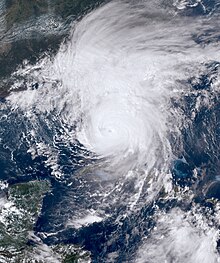 Hurricane Irma making landfall near Marco Island on September 10 | |
| Meteorological history | |
|---|---|
| Duration | September 9–11, 2017 |
| Category 4 major hurricane | |
| 1-minute sustained (SSHWS/NWS) | |
| Highest winds | 130 mph (215 km/h) |
| Highest gusts | 160 mph (260 km/h) |
| Lowest pressure | 931 mbar (hPa); 27.49 inHg |
| Overall effects | |
| Fatalities | 84 total |
| Damage | ~$50 billion (2019 USD) |
| Areas affected | Florida |
Part of the 2017 Atlantic hurricane season | |
| History
Effects
Other wikis | |
Hurricane Irma was the costliest tropical cyclone in the history of the U.S. state of Florida, before being surpassed by Hurricane Ian in 2022. Irma also was the first major hurricane[nb 1] to strike the state since Wilma in 2005 and the first Category 4 hurricane to make landfall in Florida since Charley in 2004. Irma developed from a tropical wave near the Cape Verde Islands on August 30, 2017. The storm quickly became a hurricane on August 31 and then a major hurricane shortly thereafter, but would oscillate in intensity over the next few days. By September 4, Irma resumed strengthening, and became a powerful Category 5 hurricane on the following day. The cyclone then struck Barbuda, Saint Martin, and the British Virgin Islands on September 6 and later crossed Little Inagua in the Bahamas on September 8. Irma briefly weakened to a Category 4 hurricane, but re-intensified into a Category 5 hurricane before making landfall in the Sabana-Camagüey Archipelago of Cuba. After falling to Category 3 status due to land interaction, the storm re-strengthened into a Category 4 hurricane in the Straits of Florida. Irma struck Florida twice on September 10 – the first as a Category 4 at Cudjoe Key and the second on Marco Island as a Category 3. The hurricane weakened significantly over Florida, and was reduced to a tropical storm, before exiting the state into Georgia on September 11.
Preparations for the hurricane began nearly a week before it struck the Keys, beginning with Governor Rick Scott declaring a state of emergency on September 4. With both the Atlantic and Gulf coasts of the state threatened, record evacuations ensued with an estimated 6.5 million people relocating statewide. A mandatory evacuation order was issued for all Monroe County—though roughly 25% of residents stayed—and portions of 23 other counties. The large-scale evacuation strained roadways, with gridlock reported along Interstates 75, 95, and Florida's Turnpike. A total of 191,764 people sought refuge in public shelters. All major airports saw disruption of services, resulting in the cancellation of 9,000 flights. Professional- and college-level athletics saw substantial schedule adjustments due to the storm.
The storm's large wind field resulted in strong winds across the entire state except for the western Panhandle. The strongest reported sustained wind speed was 112 mph (180 km/h) on Marco Island, while the highest observed wind gust was 142 mph (229 km/h), recorded near Naples, though stronger winds likely occurred in the Middle Florida Keys. Over 7.7 million homes and businesses were without power at some point – about 73% of electrical customers in the state, making Irma the largest power outage relating to a tropical cyclone in United States history.[2] Precipitation was generally heavy to the east of the storm's path, peaking at 21.66 in (550 mm) in Fort Pierce. Heavy rainfall – and storm surge, in some instances – caused at least 32 rivers and creeks to overflow, resulting in significant flooding, especially along the St. Johns River and its tributaries. Many homes and businesses were damaged or destroyed, including over 65,000 structures in West Central and Southwest Florida alone. Agriculture was also hit hard, suffering about $2.5 billion (2017 USD) in damage.[nb 2] It was estimated that the cyclone caused at least $50 billion in damage, making Irma the costliest hurricane in Florida history, surpassing Hurricane Andrew; however, Irma was greatly surpassed in this aspect by Hurricane Ian in 2022. The hurricane left at least 84 fatalities across 27 counties, including 12 at a nursing home due to sweltering conditions and lack of power in the hurricane's aftermath.
- ^ Cite error: The named reference
tcrwas invoked but never defined (see the help page). - ^ Why Only Some Hurricanes Cause Massive Power Outages, Urbint
Cite error: There are <ref group=nb> tags on this page, but the references will not show without a {{reflist|group=nb}} template (see the help page).
